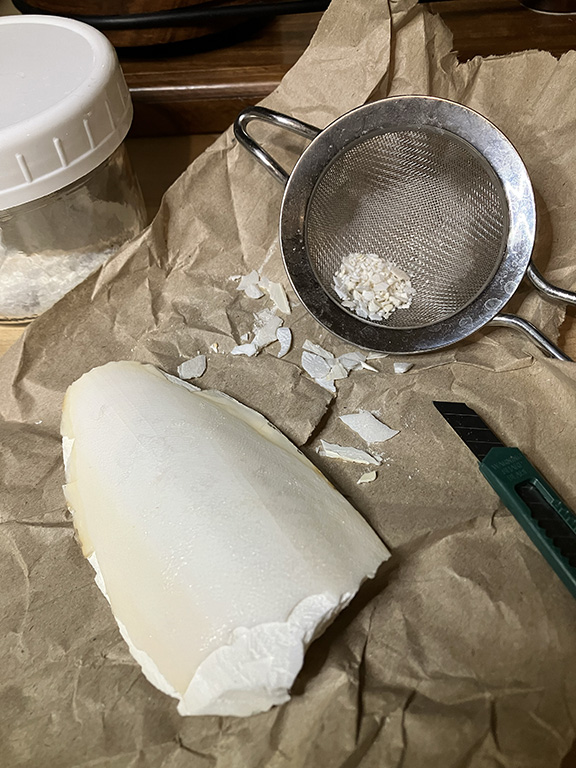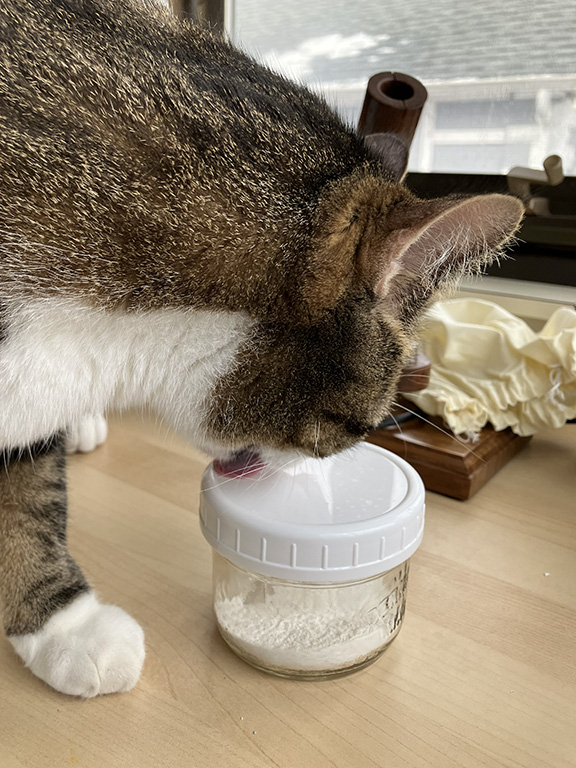As part of a goldwork embroidery project, I’ve been researching and making cuttlebone pounce powder.
What, and why? Powdered cuttlebone – the internal chalky shell of a cuttlefish, aka a squid – was, and sometimes still is, used to mark out the pattern for embroidery. The technique is called “prick and pounce” – after the pattern is drawn, the lines of the drawing are perforated, or “pricked”, the drawing is fastened to the fabric that’s going to be embroidered, pounce powder is rubbed, or “pounced”, through the holes, and the lines of dots are joined with a fine paint line. If you’d like more detail, Mary Corbet has an excellent description of the process in her blog Needle ‘n Thread.
But back to making the cuttlebone powder! I got some cuttlebone from a pet supply; it’s used for budgies as beak maintenance, entertainment, and a calcium supplement.
It weighs practically nothing, and I figured making the powder would be easy – break up the cuttlebone, then pound it up in a mortar & pestle. It wasn’t. My first attempt resisted all my efforts at reducing it to an even texture.
Finally, I put it through a sieve, and saw that what I had was a mixture of a beautifully fine powder and hard, sharp little fragments. I had a good look at the cuttlebone, and realized that what I’d thought was just discolouration due to light exposure and/or oxidization was actually a very, very hard outer shell.
Consulting the interwebs, I discovered it’s called the dorsal shield – and that the physiology of cuttlebone is an exceedingly deep rabbit hole. However, though cuttlebone physiology is fascinating, in practical terms, it means that, with the mortar & pestle, I could only break the dorsal shield into slivers, not reduce it to powder.
So I peeled the dorsal shield off. It was easy to get a knife point under it, but surprisingly hard to break it. Breaking it took so much force that a couple of pieces flew across the room and pinged off the window when they finally succumbed!
Once peeled, the cuttlebone ground up into a lovely, silky, powder.
Interestingly, our Syd the mackerel tabby found it fascinating, even in a Mason jar with the lid firmly on. Though I hadn’t noticed that it smelled fishy, with my nose practically in the jar, the powder does have a faint and far away marine tang.
Regarding research into the history of powdered cuttlebone for marking embroidery, it’s proving to be surprisingly obscure, at least on the internet. Since the project I’m working on is an SCA[1] baronial coronet based on the goldworked British guild coronets, I’m looking for 16th century or earlier sources.
So far, though I’ve found many mentions of pouncing with cuttlebone powder, they’ve all been along the lines of “it was used”, with no mention of when, by whom, and where. And to add to the fun, when I search on “cuttlebone” and “prick and pounce”, Google keeps offering mentions that da Vinci and Cellini used the method with powdered charcoal, and yields nothing on pouncing with cuttlebone besides that it’s “traditional”. Googling with just “cuttlebone” gives casting, parchment preparation, abrasives, and budgies, but no real history of needlework marking. Sigh.
I’ve sent out several enquires to people who might know; if any info surfaces, I’ll add it.
[1] The SCA – Society for Creative Anachronism – an international organization dedicated to researching, re-creating and enjoying pre-17th century arts and skills.









Leave A Comment